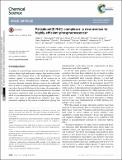Files in this item
Palladium(0) NHC complexes : a new avenue to highly efficient phosphorescence
Item metadata
| dc.contributor.author | Henwood, Adam Francis | |
| dc.contributor.author | Lesieur, Mathieu | |
| dc.contributor.author | Bansal, Ashu Kumar | |
| dc.contributor.author | Lemaur, Vincent | |
| dc.contributor.author | Beljonne, David | |
| dc.contributor.author | Thompson, David G. | |
| dc.contributor.author | Graham, Duncan | |
| dc.contributor.author | Slawin, Alexandra Martha Zoya | |
| dc.contributor.author | Samuel, Ifor David William | |
| dc.contributor.author | Cazin, Catherine S.J. | |
| dc.contributor.author | Zysman-Colman, Eli | |
| dc.date.accessioned | 2015-04-29T23:02:02Z | |
| dc.date.available | 2015-04-29T23:02:02Z | |
| dc.date.issued | 2015-05-01 | |
| dc.identifier | 178709985 | |
| dc.identifier | 814c2846-b8d9-41f2-a4b8-1d6b221c39d5 | |
| dc.identifier | 84928325241 | |
| dc.identifier | 000353223100072 | |
| dc.identifier.citation | Henwood , A F , Lesieur , M , Bansal , A K , Lemaur , V , Beljonne , D , Thompson , D G , Graham , D , Slawin , A M Z , Samuel , I D W , Cazin , C S J & Zysman-Colman , E 2015 , ' Palladium(0) NHC complexes : a new avenue to highly efficient phosphorescence ' , Chemical Science , vol. 6 , no. 5 , pp. 3248-3261 . https://doi.org/10.1039/C4SC03914A | en |
| dc.identifier.issn | 2041-6520 | |
| dc.identifier.other | ORCID: /0000-0001-7183-6022/work/56639116 | |
| dc.identifier.other | ORCID: /0000-0002-9527-6418/work/56861908 | |
| dc.identifier.uri | https://hdl.handle.net/10023/6599 | |
| dc.description | The authors are grateful to the Royal Society (University Research Fellowship to CSJC and Wolfson Research Merit Award for IDWS) and to EPSRC (grant: EP1J01771X) for financial support. EZ-C thanks the University of St Andrews for funding. | en |
| dc.description.abstract | We report the first examples of highly luminescent di-coordinated Pd(0) complexes. Five complexes of the form [Pd(L)(L’)] were synthesized, where L = IPr, SIPr or IPr* NHC ligands and L’ = PCy3, or IPr and SIPr NHC ligands. The photophysical properties of these complexes were determined in toluene solution and in solid state and contrasted to the poorly luminescent reference complex [Pd(IPr)(PPh3)]. Organic light-emitting diodes were successfully fabricated but attained external quantum efficiencies of between 0.3 and 0.7%. | |
| dc.format.extent | 1623157 | |
| dc.language.iso | eng | |
| dc.relation.ispartof | Chemical Science | en |
| dc.subject | QD Chemistry | en |
| dc.subject | DAS | en |
| dc.subject | BDC | en |
| dc.subject.lcc | QD | en |
| dc.title | Palladium(0) NHC complexes : a new avenue to highly efficient phosphorescence | en |
| dc.type | Journal article | en |
| dc.contributor.sponsor | EPSRC | en |
| dc.contributor.sponsor | EPSRC | en |
| dc.contributor.institution | University of St Andrews. School of Chemistry | en |
| dc.contributor.institution | University of St Andrews. School of Physics and Astronomy | en |
| dc.contributor.institution | University of St Andrews. EaSTCHEM | en |
| dc.contributor.institution | University of St Andrews. Condensed Matter Physics | en |
| dc.identifier.doi | 10.1039/C4SC03914A | |
| dc.description.status | Peer reviewed | en |
| dc.identifier.url | http://www.rsc.org/suppdata/sc/c4/c4sc03914a/c4sc03914a1.pdf | en |
| dc.identifier.url | http://www.rsc.org/suppdata/sc/c4/c4sc03914a/c4sc03914a2.cif | en |
| dc.identifier.url | http://www.rsc.org/suppdata/sc/c4/c4sc03914a/c4sc03914a3.cif | en |
| dc.identifier.grantnumber | EP/J01771X/1 | en |
| dc.identifier.grantnumber | EP/K039210/1 | en |
This item appears in the following Collection(s)
Items in the St Andrews Research Repository are protected by copyright, with all rights reserved, unless otherwise indicated.

